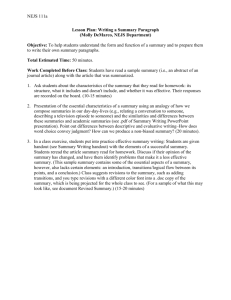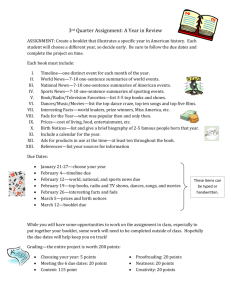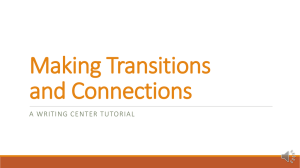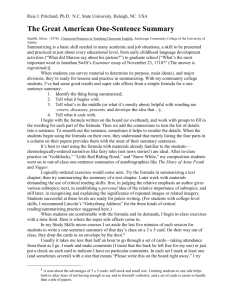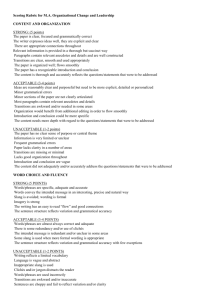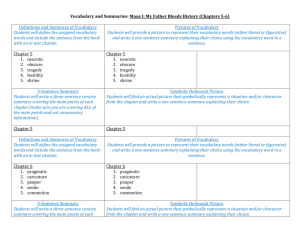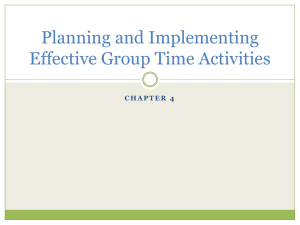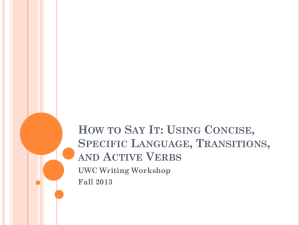What Is Summary?
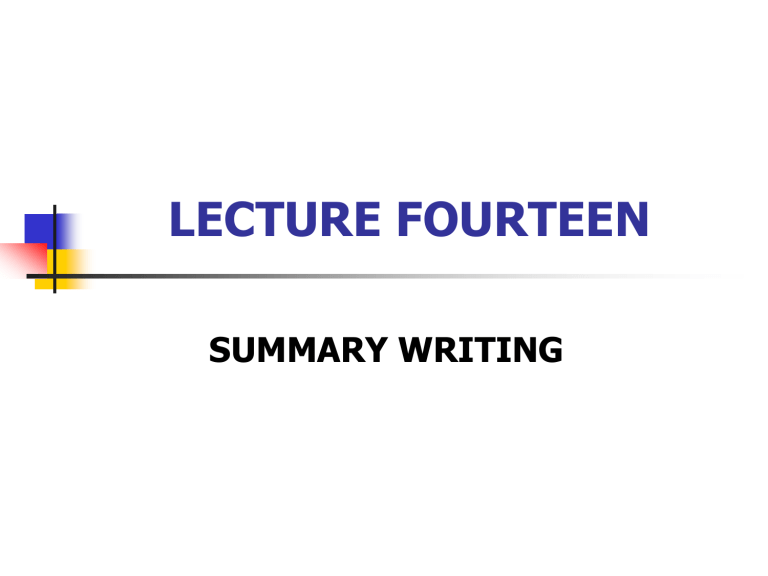
LECTURE FOURTEEN
SUMMARY WRITING
SUMMARY WRITING
Definition and characteristics
What Is Summary?
A summary is a shortened passage, which retains the essential information of the original. It is a fairly brief restatement --in your own words --- of the contents of a passage.
Note: You simply report back what the writer has said, without making value judgements.
Characteristics of a good summary
Briefness omit unnecessary details like examples, explanations and other unimportant information. (length: 1/4-1/3 of original text)
Completeness to include all the main and supporting points delivered in your own words in a condensed manner
Coherence rather than an outline listed as key words and phrase, a summary is a paragraph with necessary transitions and function structures to make it flow.
Objectivity to contain only the ideas or information of the original. Do not include your own ideas or emotions on the topic.
Steps in Writing a Summary
Read the article
Divide the article into sections of ideas.
Each section deal with one aspect of the central theme.
Label each section with a general phrase that captures the subject matter of the section.
Highlight or underline the main points and key phrases.
Steps in Writing a Summary
Write One-Sentence summaries
Write a one-sentence summary for each section of thought on a separate sheet of paper.
Steps in Writing a Summary
Formulate the Thesis Statement
Formulate a central theme that weaves the one-sentence section summaries together.
Steps in Writing a Summary
Compress supporting details
Omit the details
Reduce the examples
Simplify the descriptions
Eliminate all repetitions
Compress wordy sentences and change clauses or sentences to phrases and phrases to words.
Use general words instead of specific words
Use the shortest possible transitions
Avoid figurative language
Put the main points of a dialogue in indirect speech
Steps in Writing a Summary
Write Your First Draft
Begin with a proper citation of the title, author, source, and date of publication of the article summarised.
Combine the thesis statement and your one-sentence segment summaries into a one-to-two-paragraph summary.
Use transitions for a smooth and logical flow of ideas.
Conclude with a “ summing up ” sentence by stating what can be learned from reading the article. (optional)
Beginning a Summary
Begin your summary with the title, author of the work
In Catherine Coleman ’ s ESL 33
Spring 2008 syllabus …
Beginning a Summary
Introductory sentence should be general – in one sentence try to provide a general overview of the article
… the instructor provides details for students' successful completion of the class.
Beginning a Summary
In Catherine Coleman ’ s ESL 33 Spring
2008 syllabus, the instructor provides details for students' successful completion of the class.
Some introductory phrases
1. (The author) states in (this article) that...
2. (The author, in (this article) shows that...
3. In (this article), (the author) writes that...
4. As (the author) says in (this article), ...
5. The main idea of (the author's article) is
Organize the supporting details
Evaluate supporting details
Cover all of the author ’ s major supporting ideas.
Show the relationships among these ideas.
Omit specifics, such as illustrations, descriptions, and detailed explanations.
Omit all personal opinions, ideas, and inferences. Let the reader know that you are reporting the author ’ s ideas.
Organize the supporting details
Academic Language Reporting Verbs
Other words you can use instead of “ says ” or “ tells ” or “ talks about ” reports asks insists believes reveals observes maintains points out advises asserts implies declares notes suggests finds describes claims contends proposes establishes explains
Using transitions in the body
You will have to use transitions and other kinds of language to make your summary flow.
First the author ………… .
The author begins by stating that users should ……… .
He then points out that …… .
In the second part of the article …… ..
In the final section of the article, the author suggests …………… ..
Identify the main idea in each part.
Paraphrase the main idea
Compile sentence paraphrases
Rough Summary
Paragraph
Main idea paraphrase
Main idea
Main idea
Main idea
Summary
Points to Remember
Do not write an overly detailed summary: the point is to reduce the work to its essence.
Use your own voice.
Quote from the material sparingly to illustrate major ideas -- stick to paraphrase for the most part.
Preserve the balance and proportion of the original work.
Writing Practice
Write a summary of about 150 words on the article:

